
by Lisa Fuller | Apr 13, 2015 | Communication, General, Parenting, Sibling Issues
Sibling strife is a hot button issue. When I started writing a post on the topic it quickly became clear that I was going to write a Sibling Series to scratch the surface of this multifaceted issue.
Part One: Don’t Worry: There’s Hidden Treasure in Sibling Battles
Part Two: Your Surprising Role in Sibling Fights (& How to Change it)
Part Three: What You Say Either Helps or Hurts Sibling Relationships
Additional Resources
It’s my hope that these posts and resources inspire consideration, conversation and ultimately a deeper understanding of how we can encourage greater harmony between our children.
As always, please share your insights below in the comments. And if you’re not already receiving updates directly to your email, join me.
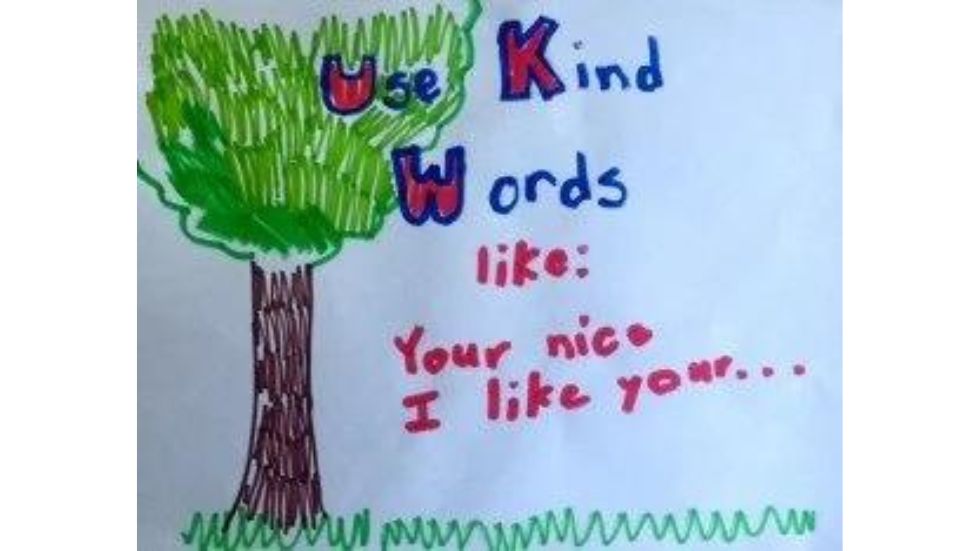
by Lisa Fuller | Apr 13, 2015 | Communication, General, Parenting, Sibling Issues
My oldest went off to college in the Fall, leaving his two younger siblings behind.
I wondered how his leaving would impact our family dynamic. And now, seven months in, I have an idea (hint: it’s not pretty).
What’s emerged is a fierceness between the remaining two. It’s like a cushion has been removed and now there’s the raw friction of two hard stones, one sharp (older one needing to be boss) and one holding firm (younger showing resolve to hold her own).
Side note: when I spoke to the kids about how I’d be depicting them for this article, they argued that they were each the one standing firm while the other was the nudger and antagonizer — confirming that there’s never “one true story” of what’s going on….
It reminds me of what Ken Kesey wrote in One Flew Over the Cuckoo’s Nest, “It’s the truth even if it never happened.”
Because I’ve parented for a while now, I know this dynamic, whatever it is, will change. It always does. But sometimes a simple dinner with the two of them is akin to nails running down the chalkboard. I’d love to run screaming from room and it makes me wonder, HOW IN THE WORLD DID I CREATE THESE MONSTERS?!
The other night at dinner we talked about what we could do to help improve the situation. My daughter (the younger one) decided that she’d make signs reminding us all of important relationship behavior.
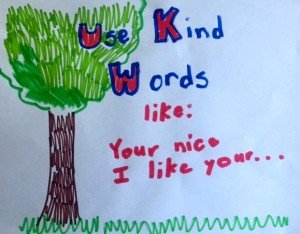
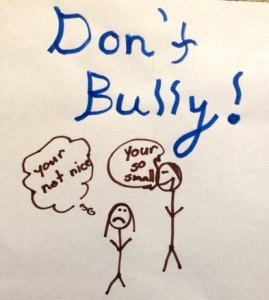
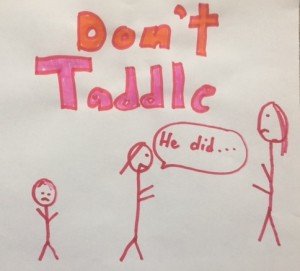 I love how her drawings show different perspectives.
I love how her drawings show different perspectives.
Once she’d created them she didn’t care to hash it out any further….
This is often the case with kids — it’s the DOING that’s important — not the processing.
Since she made these reminders, I’ve actually noticed more harmony – crazy magic.
The good the bad and the ugly news is that sibling issues, while highly irritating and button pressing, are normal and to be expected.
If you had brothers and sisters, think back to your own childhood… what did you learn from them?
Here’s a list from parents in my Parenting with Positive Discipline series:
- how to tease
- how to manipulate
- how to negotiate
- how to take turns/share
- how to stand up for someone
- how to keep company
- how to eat fast
- how to hate intensely
- how to love intensely
- how to be loyal
- how to fight
- how to defend
- how to ask for what you want or need
Sound familiar?
[tweetthis hidden_hashtags=”#parenting, #sibling battles”]We learn invaluable life lessons from our siblings.[/tweetthis]
My sister recently shared Jeffery Kluger’s Ted talk, “The sibling bond,” with me and my brother. Mr. Kluger tells stories illustrating the powerful influence siblings have on each other.
Here’s what stood out for me:.
There may be no relationship that affects us more profoundly than that of our siblings– none closer, harder, sweeter, happier, sadder, more filled with joy or fraught with woe than the relationship we have with our brothers and sisters. The sibling bond can be a thing of abiding love, our parents leave us too early, our spouses come along too late, our siblings are the only ones who are with us for the entire ride – over the arch of decades – there may be nothing that defines us and forms us more powerfully than our relationship with our brothers and sisters.
Siblings learn when to stand up for themselves, when to stand down – love, loyalty, honesty, sharing, caring, compromise, the disclosure of secrets and the keeping of confidences.
Siblings may be among the richest harvests of the time we have here.
And finally (I’ve paraphrased),
[tweetthis]Your sibling is someone you’ve road tested life with before having to get out there and travel it on your own.[/tweetthis]
Will it impact how we respond to sibling fighting if view it through this lens? I think so. Relationships are messy — we’re all learning all of the time.
When nails scratch their way down the chalkboard, take heart. Know you’re in good company. Breath, remove yourself if you can, and remember that tremendous learning is happening.
This week view sibling battles as opportunities to learn life lessons. Notice what’s being learned in your house? Notice what lessons you’d like to see more and less of and share in the comments below.
Stay tuned for Part Two: Your Surprising Role in Sibling Fights (and How to Change it)
Wanna talk? It’s easy to schedule a time here.
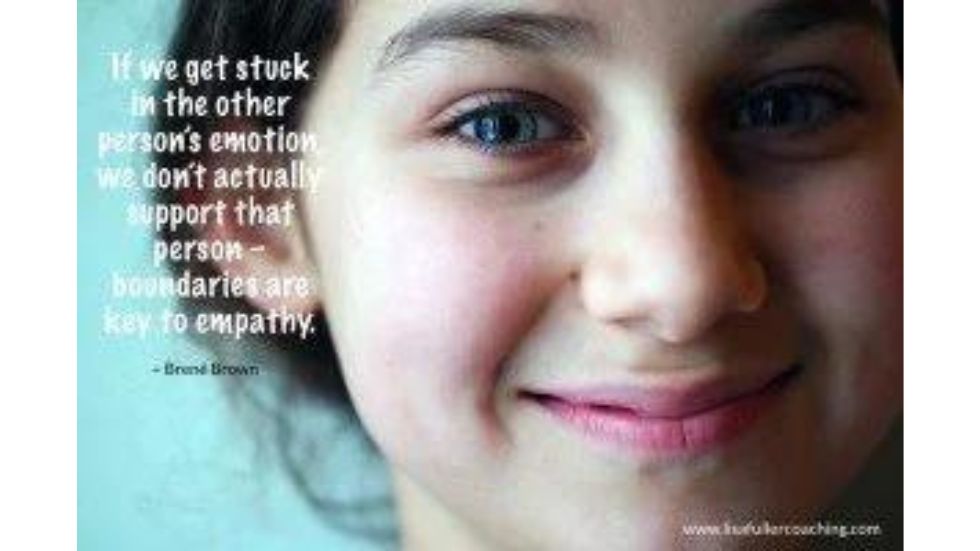
by Lisa Fuller | Jan 29, 2015 | Communication, Connection & Love, Encouragement, General, Parenting
Q: As the mother of a middle school girl, I struggle to be empathetic without jumping on the roller coaster of her ever-changing moods, emotions and dramas. And, as a woman in her late 40s, my emotions are often a 6 Flags of hormonally-induced thrills, so staying detached feels nearly impossible at times
Recently my seventh grader tried out for the school musical. After a series of micro disappointments this Fall (not making the “A” soccer team, getting put into an advisory group without any good friends, being just slightly outside of the ‘cool’ group, etc.), she was serious about getting a good part for the show. She practiced her song with a singing teacher several times and felt good about it.
Several days went by while she waited for the cast list to be posted. I worked on shifting her language away from ‘good’ and ‘bad’ parts in the show, to some limited success. I wanted to support her enthusiasm but it was draining to stay positive given my fear of the potential bad news ahead.
This daughter can be fairly stoic, but when she saw the cast list, she ran up to her room and sobbed so loudly I was afraid she would choke.
After a few minutes of trying to let her release her disappointment on her own, I went in to check on her. With your thoughts of empathy fresh in my mind, I resisted the temptation to tell her the emotions would pass or it didn’t matter or that the part was probably better than she thought, blah, blah, blah.
Instead, I let her cry, supporting the wildly strong feelings raging through her. Unfortunately, it was just a matter of time before I was crying too, and then we were both sobbing at the injustice of the world (did I mention I am a pre-menopausal woman with raging emotions?)
I managed to get myself together and put her to sleep, but then I could not stop crying. I just felt so sad for her and could not put it away. It took all the strength I had not to email the drama teacher and ask her if there was any way to revisit the cast list. Which is just a simply INSANE thing to even think, let alone seriously consider!
So here’s my question: how can we support our children with their dreams, projects, efforts and goals (especially our daughters) without getting enmeshed in the outcome? How can we let our older children navigate the disappointments and challenges of life without getting sucked into the emotional turmoil that goes along with the journey? Where do you draw the line between empathy and over involvement/attachment?
A: First, Michelle, congratulations on your success in avoiding many of the common barriers to empathy. What you did was no small feat — staying out of judgement, taking her perspective and touching a place in yourself (maybe a bit too deeply) that understood her feelings.
Simply defined as “the ability to understand and share the feelings of another,” empathy is nuanced. While you were able share your daughter’s feelings, it proved difficult to pull yourself out.
To answer your question, here are my ideas to strengthen your empathetic response even more while simultaneously moving you out of the helicopter parenting zone altogether.
From Helicopter Parenting to Empathy
- Validate her feelings. In your story Michelle, you give nice examples of how you did this — letting her cry and stay in her feelings, etc.
- Resist the urge to fix. You write, I resisted the temptation
 to tell her the emotions would pass or it didn’t matter or that the part was probably better than she thought, blah, blah, blah. This is cause for celebration! When you’re done partying let’s look at what you describe your fear of the potential bad news that she didn’t get a “good” part. Your feeling of fear fuels your underlying belief that something needs to be fixed. You can do one of two things here, keep your fear AND bite your tongue, which
to tell her the emotions would pass or it didn’t matter or that the part was probably better than she thought, blah, blah, blah. This is cause for celebration! When you’re done partying let’s look at what you describe your fear of the potential bad news that she didn’t get a “good” part. Your feeling of fear fuels your underlying belief that something needs to be fixed. You can do one of two things here, keep your fear AND bite your tongue, which
you did, or, with the help of a friend, coach or therapist, internally shift your perspective from disappointment = bad to disappointment = opportunity for growth. (I’ll go into this more in my next post). What I’m suggesting is more than a surface shift — that’s why it requires support.
- Share your own story of disappointment. By sharing a simple one sentence story of a time you didn’t make the team or you weren’t invited to the party, you let your daughter know that she’s not alone and most importantly, that she belongs. (A sense of belonging in family is profoundly impactful to a child’s sense of well-being.) For example, I remember when I longed to be chosen to play the role of Mary in the church nativity, yet I wasn’t picked and I felt terribly sad. One sentence that’s it. I can hear parents ask “Isn’t there more to say than that?!” No — children are self focused, your goal here is to simply let them know you’ve been there — voila.
- Be present. It’s not what you say that will make a difference, but simply your presence, your ability to be with your child. Ground yourself in what’s most important to you, tuck your phone and other distractions away and like the Beatles so beautifully sang, let it be.
- Practice mindfulness. Mindfulness strengthens our ability to have boundaries which according to Brené Brown’s research is key to empathy. If we get stuck in the other’s emotion, we don’t actually support that person – boundaries are key to empathy.
One of the many gifts in your story is how fully engaged you are in your daughter’s life.
Thank you Michelle for sharing your story and question, deepening our understanding of empathy. I appreciate and honor your willingness to be vulnerable — it can feel scary to divulge our struggles when we’re “supposed to be” the all-knowing parent!
Are you wanting someone to walk you through a parenting challenge like the one that Michelle shared? If so, visit my schedule to find a time for us to meet via phone or Skype.
I know that parenting is important to you — it’s worth taking time for yourself, so that you can be the parent you want to be, even in your most challenging circumstances.
Take a moment to share in the comment section below how you relate to Michelle’s story and what you want to remember from today’s post.
If you haven’t already done so, join me on this journey!
Wanna talk? Schedule a time here.
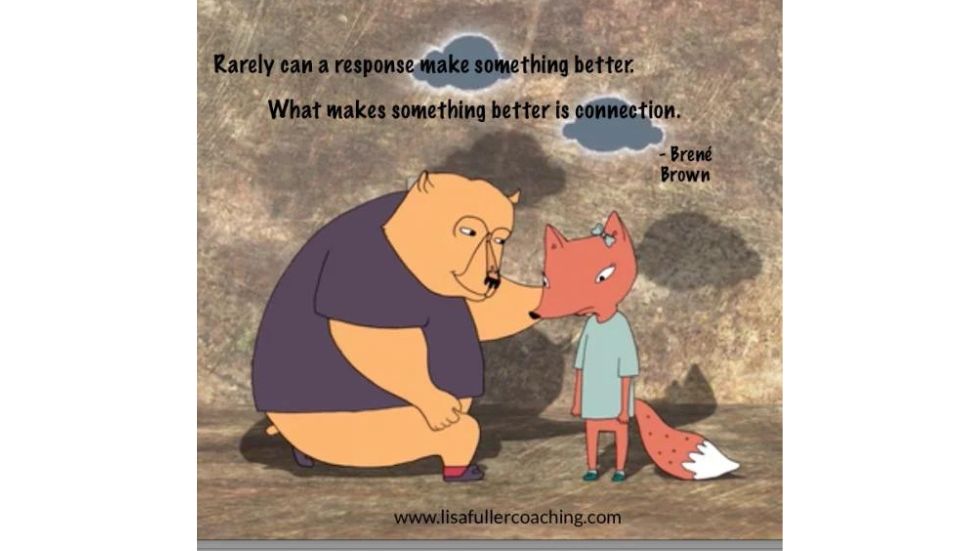
by Lisa Fuller | Dec 2, 2014 | Communication, General, Mutual Respect, Parenting, Self-regulation
In my last post, I shared how I missed an opportunity to practice empathy. Today’s story is the unexpected follow-up:
Songbird, my eight year old daughter, was at her cousin’s house. I texted my mom who was in charge, “When’s a good time for pick up?”
Mom texted back, “one hour.”
Five minutes later I receive another text, “Make that 30 minutes.” Then another message shot back “NOW.”
I head over to find Songbird curled up on the couch weeping – big sad boo hoo tears rolling down her cheeks. Mom starts to explain that cousin doesn’t want to share her new modeling clay – I hear a well-known refrain from across the room –
“It’s too special.”
Meanwhile, steady crying from Songbird.
Now comes the tongue biting as I work to keep these thoughts from tumbling out my mouth:
- It’s okay, you can put that on your Christmas list.
- I’m sure she’ll let you play with it, once she’s had it for a while.
- You’re really tired – it’s not a big deal. Now stop crying.
- Now don’t be that way Songbird, you know you can’t get everything you want.
Instead, having recently steeped myself in what empathy is and is not I wait, refrain from the above garden variety of knee jerk reactions.
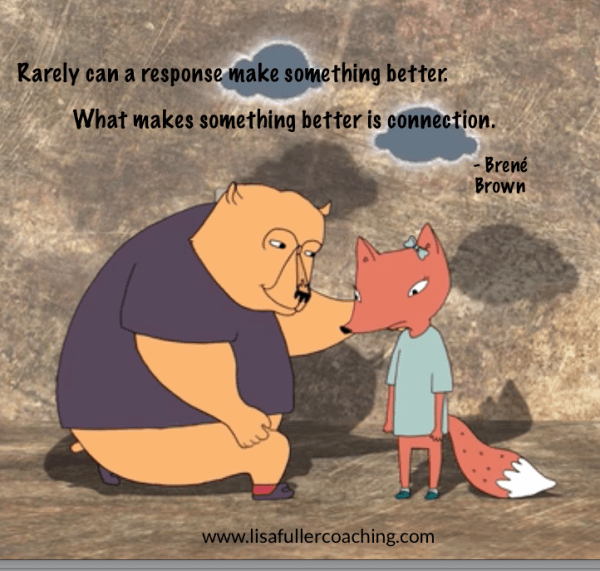 Then, consciously I say, you look sad.
Then, consciously I say, you look sad.
Songbird: Yes, I’m really sad!
Me: It seems like your heart hurts.
Songbird: Yes, (boo hooo) it hurts a lot.
Me: I’m sorry sweetie. Let’s say goodbye and go home.
Songbird: (Weep weep) Okay.
Wailing and sobbing continue as we head out to the car – they continue as we drive.
When we arrive home, 10 minutes later, Songbird gets out of the car, singing (makes sense), she skips her way to the door.
All of the usual responses we might use (those I listed above) diminish trust. When we use empathy — in this case, simply acknowledging and naming Songbird’s sadness — we build trust.
Expressing empathy in this situation was simple but not necessarily natural or easy – my bloody tongue is proof!
Simple, how? – all I did was genuinely acknowledge her emotion – naming it and finding a soft place in myself that has known that feeling too.
Not easy, how? I’ll put myself out there and say that although I’ve been teaching Positive Discipline classes for 10 years, empathy is a conscious practice, one that I only feel I’ve recently come to more fully understand.
So, today I’ve made a commitment to myself to practice deliberate empathy – and to expect I’ll make mistakes along the way. I’ll comeback around when I’ve missed the mark and attempt connection through empathy again and again.
According to the work of Theresa Wiseman and Kristin Neff, these five attributes of empathy are key. (You can see the animated video depicting these attributes, narrated by Brené Brown, by clicking the photo above.)
In this list, I’ve included examples of:
1. How I practiced this attribute in my story and
2. Common responses that act as barriers to empathy.
-
Staying out of judgment:
- Keeping my mouth closed about any internal evaluation I’m making as opposed to saying,
- “I don’t know why your cousin hasn’t learned how to share yet – at least you’re a good girl.”
-
Taking the other person’s perspective. What’s that experience like for you?
- “You look like your heart hurts.” instead of…
- “Why are you making it such a big deal? Buck up and move on!”
-
Understanding the emotion you’re hearing. How can I touch within myself something that feels like what my child may be feeling? Check in for clarity by asking questions.
- “You seem really sad.” as opposed to…
- “You really shouldn’t feel that way – you can put modeling clay on your Christmas list.”
-
Communicating our understanding about the emotion. (This seems like overkill for this example, but you might say…
- “Oh I know I feel sad when I don’t get to explore something I’m really curious about” as opposed to…
- Not understanding that emotion… “It’s really aggravating when people don’t share.”
-
Practicing mindfulness.: Rather than pushing away an emotion because it’s uncomfortable, feel it and move through it. If we get stuck in the emotion we don’t actually support the other person– boundaries are key to empathy.
- “Your heart really hurts.”
- “It’s very upsetting that your cousin won’t share with you. I’m pissed about it and will talk to her mom as soon as I can.”
Can you feel how the #2 responses edge out the space needed for empathy? Kids need a safe space to have their feelings so they can move through them and eventually let them go.
Thank you for joining me in exploring the complex nature of empathy.
The two big takeaways:
-
Empathy takes conscious awareness – it isn’t natural, especially with your loved one.
-
Empathy is not about perfection but rather a practice that you can come back to again and again – it takes being open to being vulnerable to do it.
Take a moment to share your empathy hit or miss in the comments below.
Wanna dig deep into empathy and other powerful tools? Contact me for one on one coaching!
If you haven’t already done so, join me on this journey!
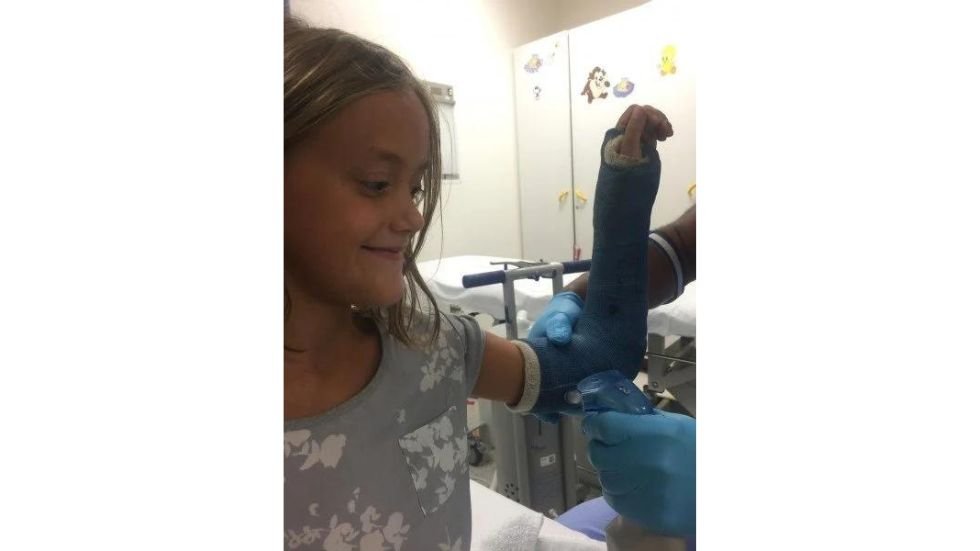
by Lisa Fuller | Nov 18, 2014 | Feelings & Emotions, General, Parenting
Until recently I thought I was really good at empathy. This was something I didn’t need to work at – heck, it came naturally! If someone was feeling pain, I was right there with them. My challenge as a young woman working in social work was to turn down my empathy so that I could be of use and make it through the day.
What I’ve become aware of through understanding and playing around with Brené Browns explanation of empathy, is that for me to be genuinely empathetic, particularly with those I’m closest to, I need to be conscious and act against my “natural” reaction to their pain.
Here’s a story from last week to illustrate. My daughter – singing bird – has been through a rough patch this fall which began with her breaking her arm. She got a cast and after two days of the weepies, was up and running. Then a week or so later I got a call from her school informing me she’d taken a bad fall, her body colliding with the concrete playground. Singing bird doesn’t cry easily so when I arrived at the school office to find her in a wimpering ball, I knew it was bad.
What I’d advise a client or friend to do in this situation: When you get your daughter home, ice pack in hand, find a quiet comfortable place where you can simply be together. Create a nest of coziness. Give your child a chance to feel all that she’s been holding in at school, her fear, her pain, her embarrassment…. Without expectations simply spend time with her. By giving her a chance to experience her emotions you’re allowing an important opportunity for her to heal, emotionally and physically. What you’ll be providing is a gift because so often we aren’t permitted our feelings. We’re told, through words and/or actions, to act appropriately. Translation: don’t express feelings of sadness, anger, disappointment, jealousy and even pain.
What I did: When we got home, I helped her out of the car and made her comfy on the couch. I got an ice pack for her head, band aides for her hip, some pain medication and a tasty melt in your mouth homeopathic remedy too. To make sure all of her senses were “soothed”, I found a television show for her to watch to further distract her from her feelings – I mean to make her feel better – heck isn’t it the same thing?
Even as I write this I’m cringing. I missed a rich opportunity to connect with her and more importantly to simply be with her – keep her company through a hard and healing time. Empathy. I avoided it. No doubt, it felt instinctual to go into fix it mode – to make her all better – to put the pain behind her.
Later that afternoon it dawned on me what I’d done. I called my sister and described the incident and how I’d missed a real opportunity for empathy. She thanked me because she was taking her daughter to the dentist for multiple tooth extraction the next day and was encouraged by the reminder.
We don’t have to fix pain or make it go away and it’s actually better if we can find a place within ourselves that allows us to be present.
(If you haven’t seen it, this short animated piece, narrated by Brené Brown is worth watching!)
What does it take for YOU to BE WITH your child when they’re in discomfort – physical or emotional? Please share in the comment section below!
For me, I know that sharing my story with you will help raise my awareness so that when my next empathy opportunity comes, and I know it will, I’ll BE there. Thanks for reading!
If you haven’t already done so, join me on this journey!
Wanna talk? Schedule a time here.
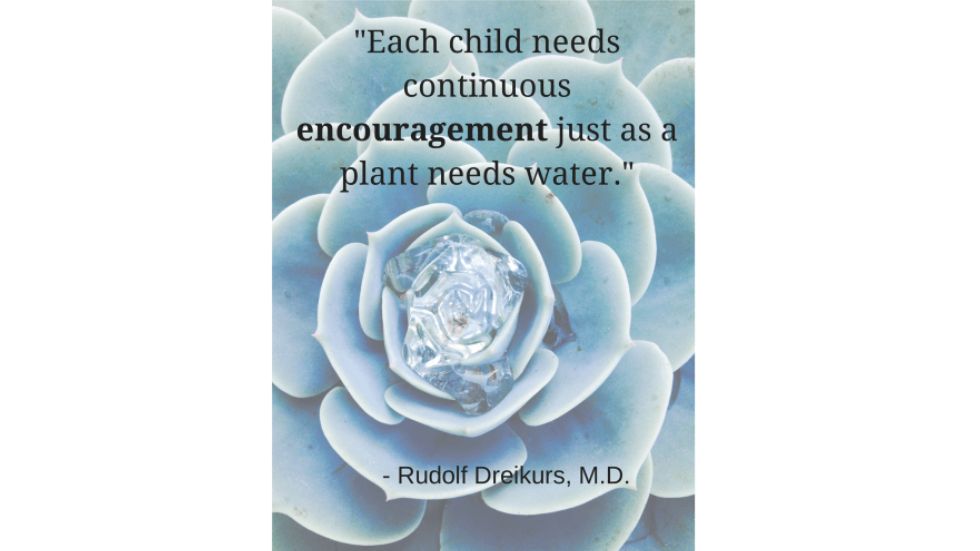
by Lisa Fuller | Oct 20, 2014 | General
My neighbor planted identical shrubs on either side of the walk up to her front door.
The one on the left looked perky while the one on the right was drooping and beginning to wither, turning from deep purple to brown.
I’m not a green thumb but when she told me her watering strategy, I had some idea of what was going on.
Here’s what had just gone down at our house. My 8 year old Sweet Pea and I planted lettuce, carrots and parsley seeds in our kitchen window box. With the water on very low, we moistened the soil consistently for 5 minutes everyday for 3 weeks. Then we stopped.
Although we continued to admire our now growing seedlings, we didn’t water them for almost two weeks.
Once we started watering again the liquid pooled on top of the now crusty soil. It collected and ran down the sides of the box, away from the target to the ground below. Water wasn’t moistening our precious seedlings.
What I learned from this experience is that water absorbs into moist soil MUCH more readily then in does in dry.
If you’re a gardener you’re probably saying duh!
Rudolf Dreikurs, one of the founders of Positive Discipline wrote, “Each child needs continuous encouragement just as a plant needs water.”
The quality of effective encouragement is like effective watering – the regular trickle seeps in with steady nourishment. In contrast, the blast of a fire hose makes everything look and feel wet in a burst, but doesn’t penetrate the soil to reach the roots.
Like the freshly planted withering shrub, children who are given the standing ovation, bask in momentary glory, but don’t get the benefit of the deep root watering.
On the other hand, the child who’s given small doses of water on a consistent basis, may not feel the big swells of pride, or show the glistening drops on their leaves. The encouragement they receive may be quiet and not even perceived by anyone other than the child.
Living in moist soil, the child continually feels it’s steady condition as part of her foundation. No run-off effect.
Here are some real life parenting examples:
Phrases that spray the surface (Praise)
- You are SO smart – I’m so proud that you got an A!
- You’re teacher just doesn’t get how smart you are – you really need a more challenging environment.
- Wow – you played so much better than all the other kids out there on the field – way to go!
- Everything you make is so beautiful – you are a true artist!
Results of Praise:
- A child may look for continual praise and approval as their source of motivation. The approval junkie syndrome – “What do you think of my picture?”
- A child may be quick to give up if they don’t think they’ll succeed easily.
- Sibling relationships are difficult because praise breeds better than/worse than feelings.
Phrases that offer a slow trickle (Encouragement)
- You studied long and hard for that test. You must feel proud of yourself. (Effort is acknowledged and seen as positive).*
- I have a strong feeling that you’ll be able to figure this out for yourself. (Having faith in)
- You spent so much time on your painting. What do you like best about it? (Asking a question looking for self reflection and acknowledging effort)
- I can see you’re disappointed that your team lost. (Energetic encouragement – keeping company through hard feelings)
Results of Encouragement:
- A child is more likely to focus on internally driven tasks.
- A child is more likely to persist at difficult tasks because the risk of failure is not an issue.
- Sibling relationships potentially more harmonious.
To get a visceral sense of the distinction between these lists put yourself on the receiving end of the statements below.
You’re amazingly smart – I’m so proud that you got an A!
Margie, you’re teacher just doesn’t get how smart you are – you really need a more challenging environment.
Wow John, you played so much better than all the other kids out there on the field – way to go!
Everything you make is so beautiful Stacy – you are a true artist!
What’s it feel like for you? For me it feels good – really good. And when I sit for a minute, I feel a bit uneasy, nervous even.
Now do the same for the encouragement.
You studied long and hard for that test Victoria. You must feel proud of yourself. (Effort is acknowledged and seen as positive).
I have a strong feeling that you’ll be able to figure this out for yourself. (Having faith in)
You spent so much time on your painting. What do you like best about it Justin? (Asking a question encouraging self reflection)
Kerry, I can see you’re disappointed that your team lost. (Energetic encouragement – keeping company through hard feelings)
How do you feel now?
If you’re like me, there’s no jolt this time around but you feel deep down good. Solid. Connected.
Here are 4 steps to help you change from praise to encouragement:
- Notice what words you commonly use to acknowledge your child
- Place sticky notes in key places (bathroom mirror, car dash) with encouragement phrases you like (Questions beginning with what and how, “I notice…”, “I have faith…,” eye contact, etc.
- Be gentle with yourself as you integrate new language, know that it will take time and will make a difference.
- Explore your own water source. Where is it and how do you tap into it? Do you need to find more sources? Email me with what you discover and let me know if you would like more support from me.
Sure, I slip back into praise sometimes but I keep in mind Jane Nelsen’s wise words – Praise is like junk food, too much of it will make you sick so dole is out sparingly.
To see more examples, check out this article in the New York Times Magazine.
Much of this post is based on research by Carol Dweck and published in Mindset.
My neighbors’ shrub is doing much better. Is there an area in your garden that needs a steady trickle?
If you haven’t already done so, join me on this journey!
Wanna talk? Schedule a time here.





 I love how her drawings show different perspectives.
I love how her drawings show different perspectives.
 to tell her the emotions would pass or it didn’t matter or that the part was probably better than she thought, blah, blah, blah. This is cause for celebration! When you’re done partying let’s look at what you describe your fear of the potential bad news that she didn’t get a “good” part. Your feeling of fear fuels your underlying belief that something needs to be fixed. You can do one of two things here, keep your fear AND bite your tongue, which
to tell her the emotions would pass or it didn’t matter or that the part was probably better than she thought, blah, blah, blah. This is cause for celebration! When you’re done partying let’s look at what you describe your fear of the potential bad news that she didn’t get a “good” part. Your feeling of fear fuels your underlying belief that something needs to be fixed. You can do one of two things here, keep your fear AND bite your tongue, which




